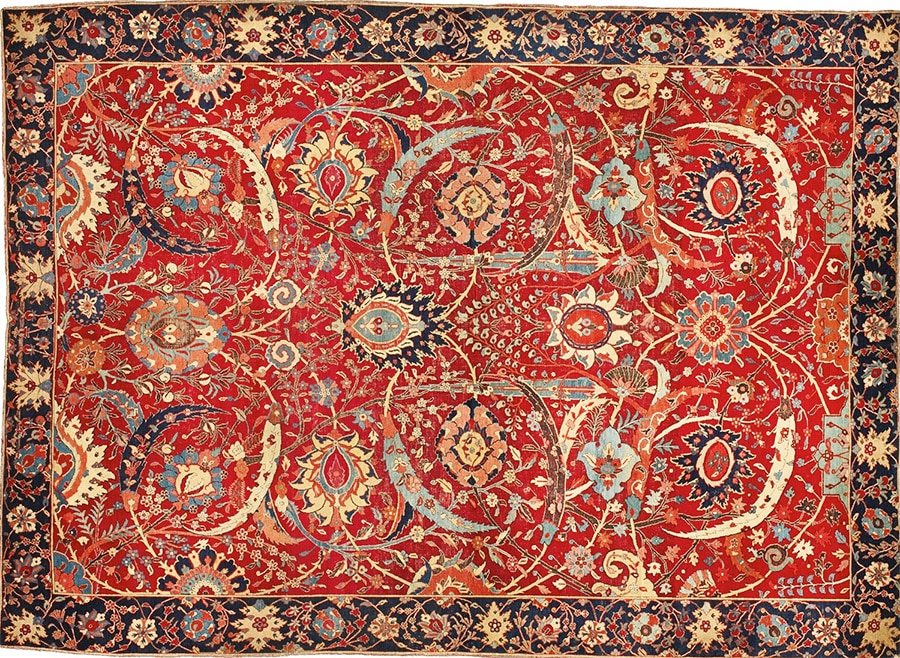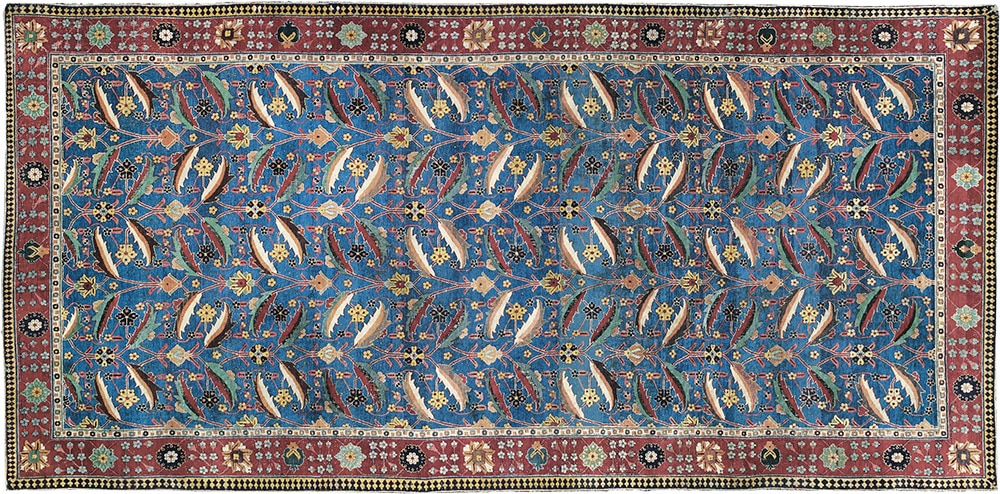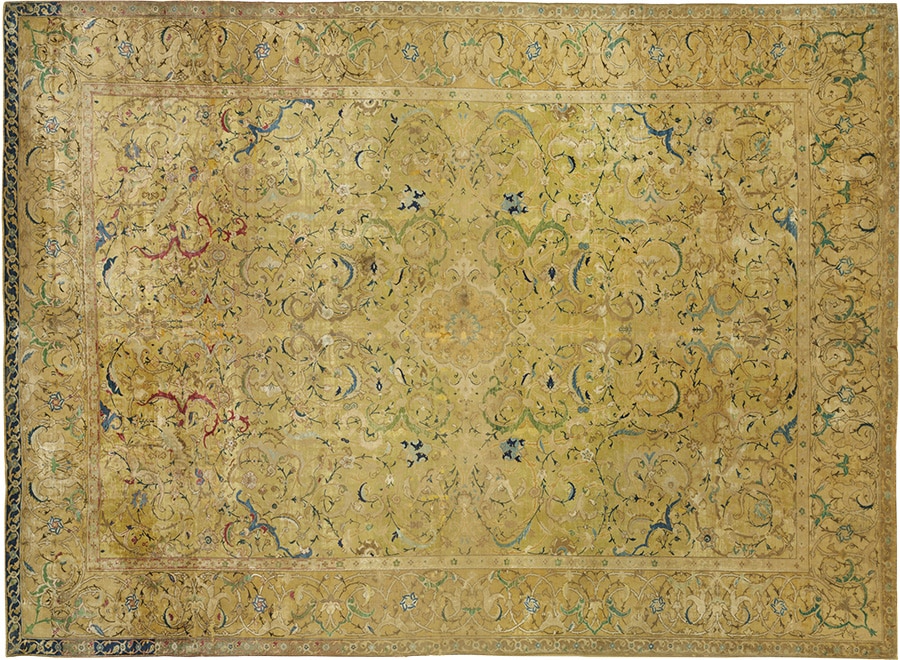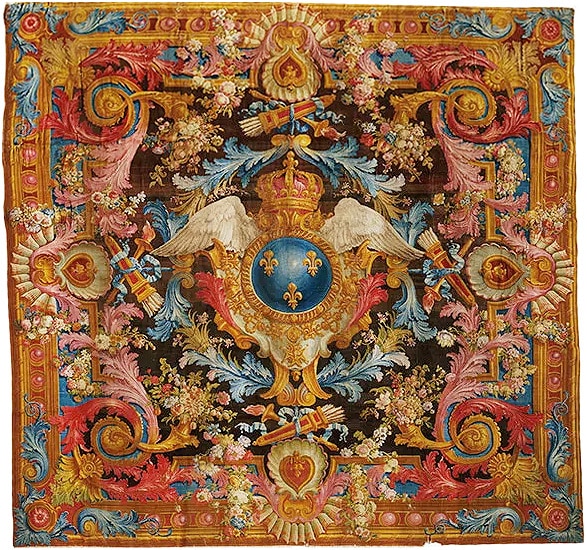A carpet is far more than a floor covering — it is a storyteller of culture, history, and the spirit of the artisans who wove it with patience and passion.
Over the centuries, some carpets have transcended their domestic origins and found their place in the grand halls of art history — admired for their intricate design, rarity, and timeless craftsmanship.
In this article, we explore six of the world’s most extraordinary and valuable carpets — masterpieces that each represent a chapter in the story of weaving art across Iran, India, and Europe. Together, they show how a carpet can simultaneously be a work of art, a cultural heritage, and a lasting investment.
1. The Clark Sickle-Leaf Carpet
Sold at Sotheby’s on June 5, 2013, for nearly $34 million, the Clark Sickle-Leaf Carpet is one of the most celebrated and valuable Persian carpets ever sold.
Renowned for its exceptional craftsmanship, dazzling design, and historical importance, it stands as a symbol of Iran’s artistic legacy.
Distinctive qualities:
- Rare design: The carpet’s unique “sickle-leaf” pattern features elongated, curved leaves arranged in symmetrical harmony — an astonishing display of precision and beauty.
- Age and origin: Dating back to the 17th century, it was woven in Persia (modern-day Iran) and remains one of the earliest surviving examples of such refinement.
- Craftsmanship: Made entirely by hand using the finest wool and silk, it showcases the masterful skill of Persian weavers.
- Historical value: Beyond its beauty, it offers insight into the cultural and aesthetic ideals of its time.
- Rarity: Few carpets of this quality have survived the centuries, making it highly sought after by collectors.
- Record price: Its sale for $33.7 million set a world record, affirming its unmatched status.
The Clark Sickle-Leaf Carpet is, in every sense, a masterpiece — where beauty, history, and value are interwoven into one timeless work of art.

2. The Comtesse de Behague Vase Carpet
The Comtesse de Behague Vase Carpet, a magnificent Kerman masterpiece, sold at Christie’s London in April 2010 for nearly $10 million.
It is celebrated as one of the most breathtaking examples of Persian weaving from the Safavid era.
Distinctive qualities:
- Design: The carpet depicts large vases overflowing with colorful flowers against a deep blue background — a testament to Safavid artistry and precision.
- Historical context: Woven in 17th-century Iran, during a golden age of Persian art and craftsmanship.
- Size and condition: Its grand scale and remarkable preservation make it exceedingly rare.
- Provenance: Once owned by Comtesse de Behague, a prominent French art collector of the early 20th century, which adds prestige and historical allure.
- Cultural value: It represents the elegance and sophistication of Persian design and serves as a bridge between past and present aesthetics.
Its 2010 sale for nearly $10 million confirmed the enduring global admiration for Persian carpets as both art and history.

3. The Vanderbilt Mughal Millefleurs Star-Lattice Carpet
Sold at Christie’s London on October 8, 2013, for about $7.6 million, this Mughal-era carpet from the collection of the wealthy American Vanderbilt family is among the finest examples of Indian weaving.
Distinctive qualities:
- Mughal artistry: Influenced by the Mughal style of the 16th–19th centuries, it features intricate floral and geometric motifs in vibrant colors.
- Millefleurs pattern: French for “a thousand flowers,” the densely packed field of tiny blossoms showcases incredible precision and delicacy.
- Star-lattice structure: The geometric star grid creates rhythm and depth, enhancing its visual richness.
- Rarity and condition: Surviving Mughal carpets in such good condition are extremely rare.
- Provenance: Its connection to the Vanderbilt family enhances its prestige and collectible value.
The Vanderbilt Mughal Millefleurs Star-Lattice Carpet unites history, art, and legacy — a living example of how weaving can reflect both mathematical beauty and human emotion.

4. The Pearl Carpet of Baroda
One of the most dazzling creations in textile history, the Pearl Carpet of Baroda was sold at Sotheby’s on March 19, 2009, for $5.5 million.
Distinctive qualities:
- Design and craftsmanship: Handwoven with exquisite symmetry, it features floral motifs, birds, and animals surrounding a radiant central medallion.
- Precious materials: Crafted from silk, gold, silver, and thousands of natural pearls, making it one of the most luxurious carpets ever created.
- Royal origin: Commissioned for the Maharaja of Baroda in 19th-century India, its royal provenance adds immense historical significance.
- Uniqueness: Very few textiles in the world combine this level of intricacy and opulence.
The Pearl Carpet of Baroda remains a breathtaking symbol of regal splendor — a true jewel among carpets.

5. The Doris Duke Silk Isfahan Carpet
The Doris Duke Silk Isfahan Carpet, sold at Christie’s on June 3, 2008, for $4.45 million, is a shining representative of Iran’s famed Isfahan weaving tradition.
Distinctive qualities:
- Historical and artistic importance: Isfahan carpets are known for their harmony of color, elegance, and intricate design — hallmarks of Persian artistry.
- Use of silk: Pure silk threads give the carpet a luminous, refined surface that shimmers beautifully with light.
- Prestigious provenance: Once part of the collection of Doris Duke, the American heiress and philanthropist, further enhancing its cultural value.
A fusion of Persian refinement, luxurious materials, and distinguished history, the Doris Duke Silk Isfahan stands as an enduring testament to Iran’s mastery in weaving art.

6. The Magnificent Louis XV Savonnerie Carpet
This grand French carpet, designed by Pierre-Josse Perrot in the 18th century and sold at Christie’s in November 2000 for $4.4 million, represents the height of European royal weaving.
Distinctive qualities:
- Savonnerie tradition: Originating in the royal Savonnerie workshops of 17th- and 18th-century France, these carpets were created for palaces and aristocrats, characterized by vibrant colors and ornate floral patterns.
- Louis XV style: Embodying the Rococo aesthetic, it combines elegance, fluid curves, and delicate gilded ornamentation.
- Artistic significance: Its design by Perrot — one of the most important designers of his era — cements its place in European art history.
- Rarity: Authentic Savonnerie carpets from the 18th century are exceptionally scarce and highly prized.
The Louis XV Savonnerie Carpet, with its regal charm and refined artistry, demonstrates how weaving in any culture can rise to the level of timeless fine art.

These six masterpieces are not only the most expensive carpets ever sold, but also among the most beautiful and influential works of textile art in human history — from the elegance of Isfahan and the splendor of Safavid Kerman to the luminous pearls of Baroda and the French grandeur of Savonnerie.
Among them, Iran’s presence shines brightest — a land whose weaving traditions have inspired artisans across the world.
At Sahand Carpet, we honor this enduring heritage, blending timeless craftsmanship with contemporary design — so that beauty, once born on the loom, continues to live beneath our feet.

